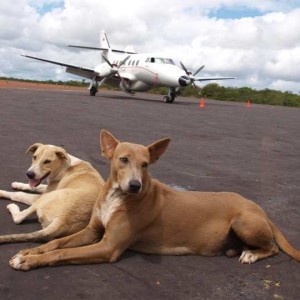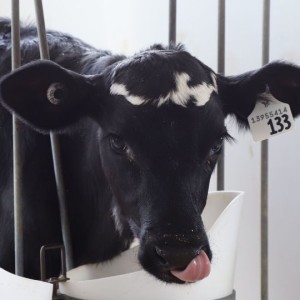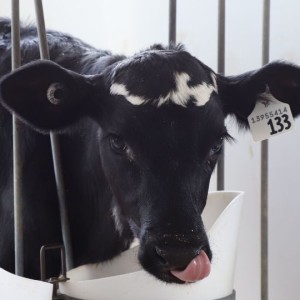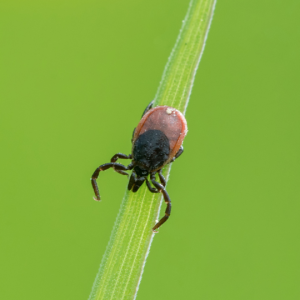CAHSS Podcast Series - Animal Health Insights
The Canadian Animal Health Surveillance System (CAHSS): A shared national vision leading to effective, responsive, integrated animal health surveillance in Canada. Le Système canadien de surveillance de la santé animale (SCSSA): Une vision nationale commune qui mènera à une surveillance efficace, souple et intégrée de la santé animale au Canada.
Episodes

Tuesday Sep 07, 2021
Tuesday Sep 07, 2021
When we bring dogs from far away into Canada, it is essential that we consider infectious organisms they may also bring into our country as “tag-alongs”. This a veterinarian and molecular-parasitology researcher (who is devoted to tackling zoonotic parasites) shares details on which infections should be top of mind when importing dogs, and describes a cautionary tale of an imported parasitic disease, Leishmania infantum.
Anyone who has been working in veterinary clinics throughout the pandemic will be all-too-aware of the increase in pet-ownership, and specifically, puppy and dog adoption, occurring throughout the past little while. Sometimes it seems that everyone, everywhere is on the hunt for a new furry companion to add to the family, and veterinarians have certainly had their hands full trying to keep up to the increased demand for veterinary medical services. Dog breeders in Canada are taking reservations years into the future for puppies, and prices for puppies are rising. Pet rescue organizations have also been scrambling to fill this “puppy void” – and increasing numbers of dogs are imported into Canada each year from far off locations. Sometimes these dogs are imported from countries where they have a drastically different climate, and potentially very different parasite and infectious disease threats for both dogs and humans.
It is impossible to keep every single infectious disease front and centre in our minds, but veterinarians know that when something seems weird or unusual, we need to call in some help. In 2020, this is exactly what happened in Quebec, Canada, when multiple veterinarians noticed some unusual things in their canine patients. And, as it turns out, these unusual findings were all observed in dogs that were imported to Canada.
Dr. Christopher Fernandez-Prada played an instrumental role in helping veterinarians investigate cases of Leishmania infantum, a parasitic infection. Dr. Fernandez-Prada is currently Director of the parasitology diagnostic laboratory and an assistant professor at the University of Montreal. In addition, he is also an Adjunct professor at McGill University faculty of Medicine, Deputy director of the Animal Infectious Diseases Research Group, and he is a member of the steering committee of the Canadian Network in Neglected Tropical Diseases. Recently, Dr. Fernandez Prada was the first veterinarian to receive the Canadian Institutes of Health Research prize – the Bhagirath Singh Early Career Award in Infection and Immunity.
Links of Interest:
Leishmania infantum infection in a dog imported from Morocco. Wagner V, Douanne N, Fernandez-Prada C. Leishmania infantum infection in a dog imported from Morocco. The Canadian Veterinary Journal = La Revue Veterinaire Canadienne. 2020 Sep;61(9):963-965. PMID: 32879521; PMCID: PMC7424924._
A flesh-eating parasite carried by dogs is making its way to North America. Victoria Wagner, Christopher Fernandez-Prada, Martin Olivier. The Conversation, Oct. 21, 2020.
Unravelling the proteomic signature of extracellular vesicles released by drug-resistant Leishmania infantum parasitesDouanne N, Dong G, Douanne M, Olivier M, Fernandez-Prada C (2020) Unravelling the proteomic signature of extracellular vesicles released by drug-resistant Leishmania infantum parasites. PLOS Neglected Tropical Diseases 14(7): e0008439. https://doi.org/10.1371/journal.pntd.0008439
Dr. Christopher Fernandez-Prada and his research

Tuesday Sep 07, 2021
Tuesday Sep 07, 2021
Toute personne ayant travaillé dans une clinique vétérinaire pendant la pandémie sait trop bien que les adoptions d’animaux de compagnie, en particulier de chiots et de chiens, sont en hausse depuis quelque temps. On dirait parfois que tout le monde, partout, est en quête d’un nouveau compagnon à fourrure à ajouter à la famille, et les médecins vétérinaires sont très occupés à essayer de suffire à la demande accrue pour les services de santé vétérinaire. Les éleveurs de chiens du Canada prennent des réservations plusieurs années d’avance pour fournir des chiots, et les prix de ces chiots augmentent. Les organismes de sauvetage d’animaux de compagnie font aussi des pieds et des mains pour combler ce « manque de chiots » – et de plus en plus de chiens d’endroits éloignés sont importés au Canada chaque année. Ils viennent parfois de pays où le climat est radicalement différent et où des parasites et des maladies infectieuses très différents peuvent poser une menace pour la santé des chiens et des humains. Quand nous importons des chiens de très loin, il est essentiel de penser aux petits « passagers » contagieux qu’ils peuvent apporter avec eux dans notre pays.
Dr Fernandez-Prada est un médecin vétérinaire et chercheur en parasitologie moléculaire spécialiste des parasites zoonotiques. Il est directeur du laboratoire de diagnostic en parasitologie et professeur adjoint à l’Université de Montréal. Il est aussi professeur associé à la Faculté de médecine de l’Université McGill, directeur adjoint du Groupe de recherche sur les maladies infectieuses en production animale et membre du comité directeur du Réseau canadien pour les maladies tropicales négligées. Et il est récemment devenu le premier médecin vétérinaire à recevoir le prix Bhagirath-Singh de début de carrière en recherche en maladies infectieuses et immunitaires décerné par les Instituts de recherche en santé du Canada.
Liens d’intérêt:
Infection par Leishmania infantum chez un chien importé du Maroc. (Wagner V, Douanne N, Fernandez-Prada C. Leishmania infantum infection in a dog imported from Morocco. The Canadian Veterinary Journal = La Revue Veterinaire Canadienne. 2020 Sep;61(9):963-965. PMID: 32879521; PMCID: PMC7424924._)
A flesh-eating parasite carried by dogs is making its way to North America. Victoria Wagner, Christopher Fernandez-Prada, Martin Olivier. The Conversation, Oct. 21, 2020.
Unravelling the proteomic signature of extracellular vesicles released by drug-resistant Leishmania infantum parasitesDouanne N, Dong G, Douanne M, Olivier M, Fernandez-Prada C (2020) Unravelling the proteomic signature of extracellular vesicles released by drug-resistant Leishmania infantum parasites. PLOS Neglected Tropical Diseases 14(7): e0008439. https://doi.org/10.1371/journal.pntd.0008439
Dr. Christopher Fernandez-Prada et ses recherches

Saturday Aug 07, 2021
Saturday Aug 07, 2021
We're all racing neck and neck against antimicrobial resistance - trying to preserve antibiotics for use in the most critical situations. This equine specialist pinpoints actions horse owners and veterinarians can take to minimize spread of resistant pathogens in horse populations and facilities.
With fewer anti-microbials in our equine veterinary toolkit, it is essential that we learn all we can about how antimicrobial resistant pathogens travel between horses and their handlers. Without being able to identify and track antibiotic resistant bacteria, we are left in the dark when we try to adjust our management of our animals to minimize disease and to save these valuable medications for situations where they are absolutely necessary.
Dr. Maud de Lagarde is a researcher and diplomate of the American College of Veterinary Internal Medicine who studies the movement of antimicrobial resistant genes in bacterial populations that affect horses in both Quebec and France. She is specifically interested in their route of dissemination to develop strategies to prevent antimicrobial resistance, and her work highlights some interesting intervention points for horse owners and veterinarians alike.
Links of Interest:
Prevalence, risk factors, and characterization of multidrug resistant and extended spectrum β-lactamase/AmpC β-lactamase producing Escherichia coli in healthy horses in France in 2015 (de Lagarde M, Larrieu C, Praud K, Schouler C, Doublet B, Sallé G, Fairbrother JM, Arsenault J. Prevalence, risk factors, and characterization of multidrug resistant and extended spectrum β-lactamase/AmpC β-lactamase producing Escherichia coli in healthy horses in France in 2015. J Vet Intern Med. 2019 Mar;33(2):902-911. doi: 10.1111/jvim.15415. Epub 2019 Jan 15. PMID: 30648296; PMCID: PMC6430864.)
Prevalence, Risk Factors, and Characterization of Multidrug Resistant and ESBL/AmpC Producing Escherichia coli in Healthy Horses in Quebec, Canada, in 2015–2016 (de Lagarde M, Fairbrother JM, Arsenault J. Prevalence, Risk Factors, and Characterization of Multidrug Resistant and ESBL/AmpC Producing Escherichia coli in Healthy Horses in Quebec, Canada, in 2015-2016. Animals (Basel). 2020;10(3):523. Published 2020 Mar 20. doi:10.3390/ani10030523)
Spread of multidrug-resistant IncHI1 plasmids carrying ESBL gene bla CTX-M-1 and metabolism operon of prebiotic oligosaccharides in commensal Escherichia coli from healthy horses, France (Maud de Lagarde, Caroline Larrieu, Karine Praud, Nathalie Lallier, Angélina Trotereau, Guillaume Sallé, John M. Fairbrother, Catherine Schouler, Benoît Doublet, Spread of multidrug-resistant IncHI1 plasmids carrying ESBL gene blaCTX-M-1 and metabolism operon of prebiotic oligosaccharides in commensal Escherichia coli from healthy horses, France, International Journal of Antimicrobial Agents, Volume 55, Issue 6, 2020, 105936, ISSN 0924-8579)

Saturday Aug 07, 2021
Saturday Aug 07, 2021
Nous sommes tous engagés dans une course contre la résistance aux antibiotiques et nous essayons de préserver l’efficacité de ces médicaments pour pouvoir continuer à les utiliser dans les situations les plus critiques. Cette spécialiste en médecine équine propose aux propriétaires de chevaux et aux vétérinaires équins des mesures qui peuvent être utilisées pour réduire la propagation de bactéries pathogènes résistantes au sein de la population équine et dans les écuries.
Étant donné la réduction du nombre d’antibiotiques disponibles dans la trousse médicale des vétérinaires équins, il est essentiel que ces derniers aient accès à un maximum de connaissances concernant la façon dont les bactéries pathogènes résistantes aux antibiotiques peuvent se transmettre entre les chevaux et leurs propriétaires. Si les vétérinaires équins ne savent pas comment identifier et suivre les mouvements des bactéries résistantes aux antibiotiques, il leur est difficile d’adapter la gestion de leurs cas pour réduire le risque de maladies et réserver ces médicaments importants aux situations pour lesquelles ils sont absolument nécessaires.
Dre Maud de Lagarde est chercheure et diplomée du Collège américain de médecine interne vétérinaire (ACVIM). Elle étudie les mouvements des gènes de résistance aux antibiotiques dans les populations bactériennes retrouvées chez les chevaux au Québec et en France. Elle s’intéresse particulièrement à la façon dont ces gènes se propagent afin de développer des stratégies de prévention de la résistance. Son travail souligne des possibilité d’interventions concrètes pour les propriétaires de chevaux et leurs vétérinaires.
Liens d’intérêt:
Prevalence, risk factors, and characterization of multidrug resistant and extended spectrum β-lactamase/AmpC β-lactamase producing Escherichia coli in healthy horses in France in 2015 (de Lagarde M, Larrieu C, Praud K, Schouler C, Doublet B, Sallé G, Fairbrother JM, Arsenault J. Prevalence, risk factors, and characterization of multidrug resistant and extended spectrum β-lactamase/AmpC β-lactamase producing Escherichia coli in healthy horses in France in 2015. J Vet Intern Med. 2019 Mar;33(2):902-911. doi: 10.1111/jvim.15415. Epub 2019 Jan 15. PMID: 30648296; PMCID: PMC6430864.)
Prevalence, Risk Factors, and Characterization of Multidrug Resistant and ESBL/AmpC Producing Escherichia coli in Healthy Horses in Quebec, Canada, in 2015–2016 (de Lagarde M, Fairbrother JM, Arsenault J. Prevalence, Risk Factors, and Characterization of Multidrug Resistant and ESBL/AmpC Producing Escherichia coli in Healthy Horses in Quebec, Canada, in 2015-2016. Animals (Basel). 2020;10(3):523. Published 2020 Mar 20. doi:10.3390/ani10030523)
Spread of multidrug-resistant IncHI1 plasmids carrying ESBL gene bla CTX-M-1 and metabolism operon of prebiotic oligosaccharides in commensal Escherichia coli from healthy horses, France (Maud de Lagarde, Caroline Larrieu, Karine Praud, Nathalie Lallier, Angélina Trotereau, Guillaume Sallé, John M. Fairbrother, Catherine Schouler, Benoît Doublet, Spread of multidrug-resistant IncHI1 plasmids carrying ESBL gene blaCTX-M-1 and metabolism operon of prebiotic oligosaccharides in commensal Escherichia coli from healthy horses, France, International Journal of Antimicrobial Agents, Volume 55, Issue 6, 2020, 105936, ISSN 0924-8579)

Tuesday Jul 13, 2021
Tuesday Jul 13, 2021
Sharing information about Salmonella Dublin, an emerging pathogen of cattle, is essential to improve health, manage disease and minimize losses. This epidemiologist of infectious diseases of dairy cattle discusses some innovative ways to share Salmonella Dublin risk and prevalence information with producers and veterinarians.
For the past number of years, in our cattle populations, veterinarians and producers have dealt with a host-adapted strain of Salmonella that causes significant respiratory disease and sepsis in calves and can cause major production losses for an infected herd. Veterinarians work hard with their producers to set up biosecurity and treatment protocols on farm to help minimize new infections and manage risk factors, but there is also a lot of exciting work going on at Universities, and with governments and disease surveillance organizations to establish programs to effectively monitor outbreaks, track infections, and communicate this disease prevalence and risk information back to producers and veterinarians.
Dr. Simon Dufour, a Professor in the Department of Pathology and Microbiology at the Faculty of Veterinary medicine at the University of Montreal, joins us to share some information on Salmonella Dublin infections in dairy calves and cattle, and to discuss some collaborative projects that are in the works to help manage this important emerging pathogen.
Links of Interest:
Dr. Dufour and his research
S’attaquer à Salmonella Dublin au Québec, La revue Le producteur de lait québécois, Dec. 2019
Project in progress: Diagnostic of Salmonella Dublin infection in Québec dairy herds
Salmonella Dublin, calfcare.ca
Dairy Knowledge Summary, Salmonella Dublin, from the Dairy Research and Extension Consortium of Alberta, Jan. 2020

Tuesday Jul 13, 2021
Tuesday Jul 13, 2021
Il est essentiel de partager de l’information à propos de ce pathogène en émergence chez les bovins afin d’améliorer la santé, gérer la maladie et réduire les pertes qui y sont associées. Ce spécialiste en épidémiologie des maladies infectieuses des bovins laitiers discute de nouvelles façons de partager de l’information aux producteurs et aux vétérinaires à propos des risques et de la prévalence de cette maladie.
Dr Simon Dufour, professeur au département de pathologie et de microbiologie de la faculté de médecine vétérinaire de l’Université de Montréal, va nous partager de l’information au sujet des infections à Salmonella Dublin dans les élevages laitiers, va discuter de certains projets en cours pour aider à gérer cet important pathogène en émergence.
Liens d’intérêt:
Dr. Dufour et ses recherches
S’attaquer à Salmonella Dublin au Québec, La revue Le producteur de lait québécois, Dec. 2019
Projet en cours: Diagnostic of Salmonella Dublin infection in Québec dairy herds
Salmonella Dublin: CalfCare.ca

Tuesday Jun 01, 2021
Tuesday Jun 01, 2021
Ticks are becoming increasingly common in Canada; posing a variety of disease threats to animal and human health. This scientist and tick expert provides an update on ticks of concern, tick-borne disease risks, and shares some highlights and cringe-worthy tales from the day-to-day life of a tick specialist.
There are many tick species, and they each can carry and potentially spread a mind-numbing number of disease conditions to us, our pets, and our livestock. Luckily there are experts in both the veterinary and human medical realm who actively research and monitor these pesky vectors and help to alert professionals in practice to emerging disease threats.
Dr. Robbin Lindsay and his research team have been actively involved in tick surveillance across Canada for several decades and generate critical data related to geographic range of vector ticks and tick-borne disease prevalence with the Public Health Agency of Canada, in the Zoonotic Diseases and Special Pathogens section of the National Microbiology Laboratory. Dr. Lindsay is an expert in all things tick-related, and he shares information on current and emerging ticks and tick-borne pathogens, the evolution of tick-surveillance in Canada, and some ways to minimize these risks for both ourselves and our animals.
Links of Interest:
www.etick.ca
The Canadian Lyme Disease Research Network, Dr. Robbin Lindsay
More information about Dr. Lindsay's work with the Public Health Agency of Canada
Tick Talk Canada, from the Canadian Veterinary Medical Association
Pets and Ticks

Tuesday May 04, 2021
Tuesday May 04, 2021
Infectious disease enters a barn the same way you do.. through the door! This poultry veterinarian shares how a few extra steps can change the movement of pathogens into farms and lower disease risk.
When veterinarians discuss disease prevention, they often talk about the importance of excellent biosecurity practices. Biosecurity refers to the protective measures put in place to minimize the chance that any infectious pathogen, such as a virus or bacteria, can make it’s way from the outside of the farm to the inside of the barn; infecting a herd or a flock. In the face of an emerging disease or other disease threat, veterinarians will emphasize that producers should work to increase biosecurity measures. Sometimes, it can be difficult to imagine how these biosecurity changes may actually impact animal health - since some of the measures seem so simple and common sense.
Dr. Geneviève Huard, a poultry veterinarian and researcher, worked on a project that provides visual evidence of how pathogens can move into our barn facilities, and shows what we can do to keep pathogens outside the barn.
Links of Interest:
Poultry Production, Penn State Extension
Biosecurity Basics for Poultry Growers, University of Georgia
Government of Canada, Animal Biosecurity
Avian Biosecurity, Government of Canada
Biosecurity, Nova Scotia
Animal Health and Biosecurity, Manitoba
B.C. Poultry Biosecurity Reference Guide
Biosecurity Fundamentals for Visitors to Livestock Facilities, Ontario Ministry of Food, Agriculture and Rural Affairs



